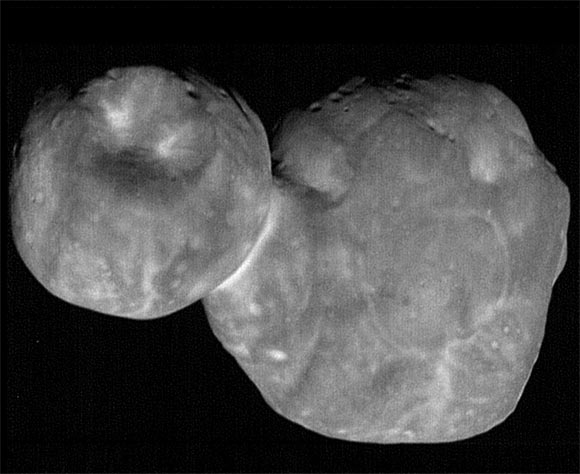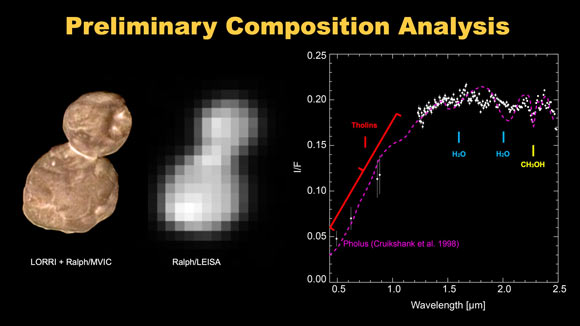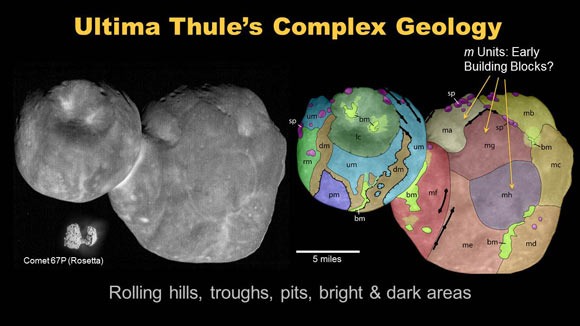Analyzing the data NASA’s New Horizons spacecraft has been sending home since the flyby of the Kuiper Belt object Ultima Thule, the mission team is learning more about the development, geology and composition of this pristine planetesimal, a building block of the planets.

This composite picture combines nine individual images taken with New Horizons’ Long Range Reconnaissance Imager (LORRI), each with an exposure time of 0.025 seconds, just 6 ½ minutes before the spacecraft’s closest approach to Ultima Thule. The image was taken at 12:26 a.m. EST (5:26 a.m. GMT) on January 1, 2019, when the spacecraft was 4,109 miles (6,628 km) from Ultima Thule and 4.1 billion miles (6.6 billion km) from Earth. The angle between the spacecraft, Ultima Thule and the Sun — known as the ‘phase angle’ – was 33 degrees. Image credit: NASA / Johns Hopkins Applied Physics Laboratory / Southwest Research Institute / National Optical Astronomy Observatory.
Ultima Thule is the first unquestionably primordial contact binary ever explored.
At 22 miles (35 km) long, the object consists of a large, flat lobe (nicknamed ‘Ultima’) connected to a smaller, rounder lobe (nicknamed ‘Thule’). This strange shape is the biggest surprise, so far, of the flyby.
“We’ve never seen anything like this anywhere in the Solar System. It is sending the planetary science community back to the drawing board to understand how planetesimals form,” said New Horizons principal investigator Dr. Alan Stern, a researcher at the Southwest Research Institute.
Because it is so well preserved, Ultima Thule is offering our clearest look back to the era of planetesimal accretion and the earliest stages of planetary formation.
Apparently its two lobes once orbited each other, like many so-called binary worlds in the Kuiper Belt, until something brought them together in a ‘gentle’ merger.
“This fits with general ideas of the beginning of our Solar System. Much of the orbital momentum of the Ultima Thule binary must have been drained away for them to come together like this. But we don’t know yet what processes were most important in making that happen,” said New Horizons co-investigator Dr. William McKinnon, of Washington University in St. Louis.
“That merger may have left its mark on the surface. The ‘neck’ connecting Ultima and Thule is reworked, and could indicate shearing as the lobes combined,” added New Horizons science team member Dr. Kirby Runyon, from the Johns Hopkins Applied Physics Laboratory.
The team is trying to understand Ultima Thule’s many surface features, from bright spots and patches, to hills and troughs, to craters and pits.
The craters, while at first glance look like impact craters, could have other origins. Some may be pit craters, where material drains into underground cracks, or a result of sublimation, where ice went directly from solid to gas and left pits in its place.
The largest depression, nicknamed Maryland crater, is about 5 miles (8 km) wide. It could be an impact crater, or it could have formed in one of the other above-mentioned ways.
“We have our work cut out to understand Ultima Thule’s geology, that is for sure,” Dr. Runyon said.

Surface composition of Ultima Thule. Image credit: NASA / Johns Hopkins University Applied Physics Laboratory / Southwest Research Institute.

Geology of Ultima Thule. Image credit: NASA / Johns Hopkins University Applied Physics Laboratory / Southwest Research Institute.
In color and composition, New Horizons data revealed that Ultima Thule resembles many other objects found in its region of the Kuiper Belt.
Consistent with pre-flyby observations from the NASA/ESA Hubble Space Telescope, Ultima Thule is very red — redder even than Pluto, which New Horizons flew past on the inner edge of the Kuiper Belt in 2015 — and about the same color as many other so-called ‘cold classical’ Kuiper Belt objects.
“This is the first time one of these ‘ultra red’ objects has been explored, and our observations open all kinds of new questions,” said New Horizons science team member Dr. Carly Howett, from the Southwest Research Institute.
“The color imaging even reveals subtle differences in coloration across the surface, and we really want to know why.”
The scientists also found evidence for methanol, water ice and organic molecules on the surface of Ultima Thule.
“The spectrum of Ultima Thule is similar to some of the most extreme objects we’ve seen in the outer Solar System,” said New Horizons co-investigator Dr. Silvia Protopapa, also from the Southwest Research Institute.
“So New Horizons is giving us an incredible opportunity to study one of these bodies up close.”
The New Horizons science team presented the findings this week at the 50th Lunar and Planetary Science Conference in The Woodlands, Texas.







